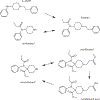Degradation of immediate precursors of fentanyl and fentalogs
- PMID: 40241819
- PMCID: PMC11998922
- DOI: 10.1016/j.forc.2024.100573
Degradation of immediate precursors of fentanyl and fentalogs
Abstract
Remediation of clandestine laboratory and processing operations for fentanyl and its analogs (i.e., fentalogs) may involve application of oxidants, most commonly household hypochlorite bleach, to chemically degrade the fentanyl to enable disposition of the site. While the chemical degradation of fentanyl has been reported, the degradation of immediate precursors has not been. Chemical degradation of fentanyl and fentalogs can cause these immediate precursors to reform. The immediate precursors of fentanyl investigated here are norfentanyl and 4-ANNP, which are controlled substances, along with norcarfentanil, precursor for carfentanil and remifentanil. The 4-ANNP was degraded within minutes in chlorine bleach, somewhat faster than fentanyl itself, whereas norfentanyl and norcarfentanil showed apparent degradation half lives up to days. Also, degradation rates were reduced in the presence of common diluents, like cutting agents, with apparent half-lives of several weeks for fully dissolved solutions. When the fentalog was added as a powder, globules were observed which could indefinitely prevent contact between the chlorine and the contents of the globules, prolonging persistence unless the globules are mechanically or otherwise broken. Because of shared structural characteristics among fentalogs, such as presence of reactive nitrogen groups, the results of this study may be applicable to a wide array of fentalogs. This study may also help inform remediation and waste management strategies to provide not only effective remediation of contamination, but also reduce the possibility that wastes of controlled substances are handled inappropriately, e.g., leading to continued personnel exposure and/or reprocessing of controlled substances.
Keywords: Bleach; Degradation; Fentalog; Fentanyl; Precursor.
Figures



References
-
- CDC, Opiods, https://www.cdc.gov/opioids/index.html, accessed August 2023, (2023).
-
- NIH Opiods, https://nida.nih.gov/research-topics/opioids, accessed August 2023, (2023).
-
- Pardo B, Taylor J, Caulkins JP, Kilmer B, Reuter P, Stein BD, The future of fentanyl and other synthetic opioids, RAND Corporation, Santa Monica, CA, 2019.
-
- EPA, Fact sheet for OSCs: Fentanyl and fentanyl analogs, https://www.epa.gov/emergency-response/fact-sheet-fentanyl-and-fentanyl-... accessed Jan 2024, (2018).
-
- EPA, Voluntary guidelines for methamphetamine and fentanyl laboratory cleanup, https://www.epa.gov/emergency-response/voluntary-guidelines-methamphetam..., accessed Jan 2024, (2021).
Grants and funding
LinkOut - more resources
Full Text Sources
